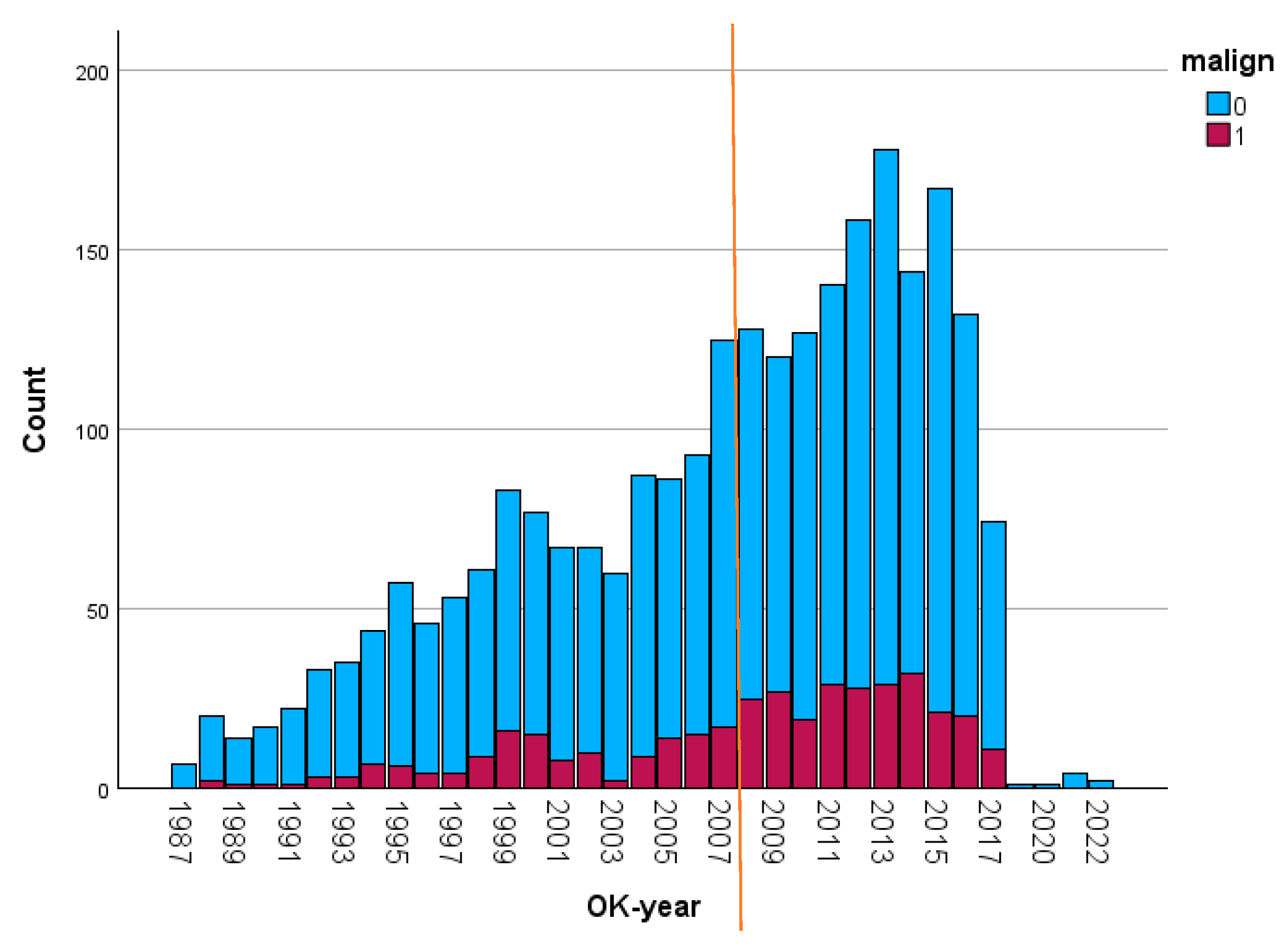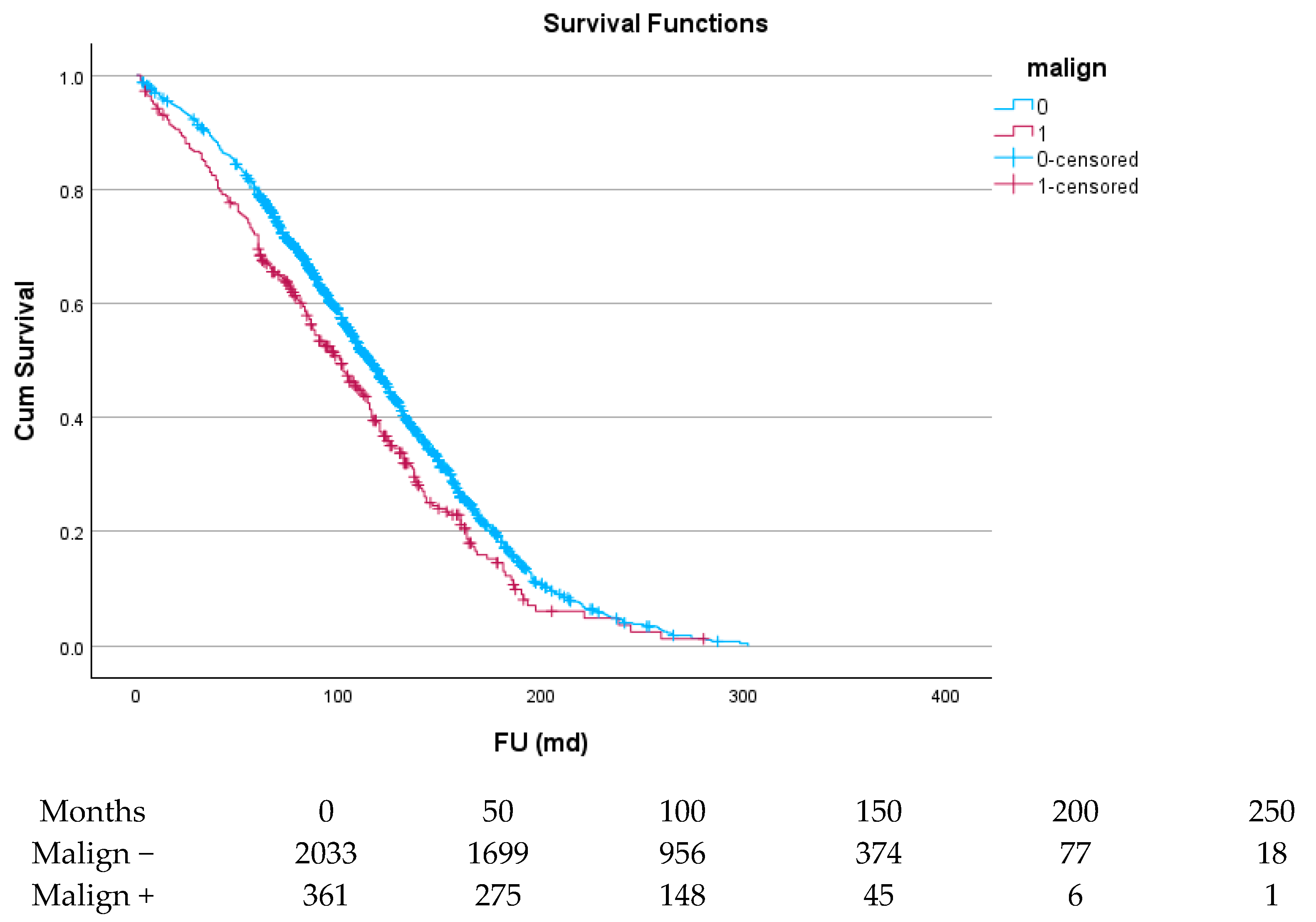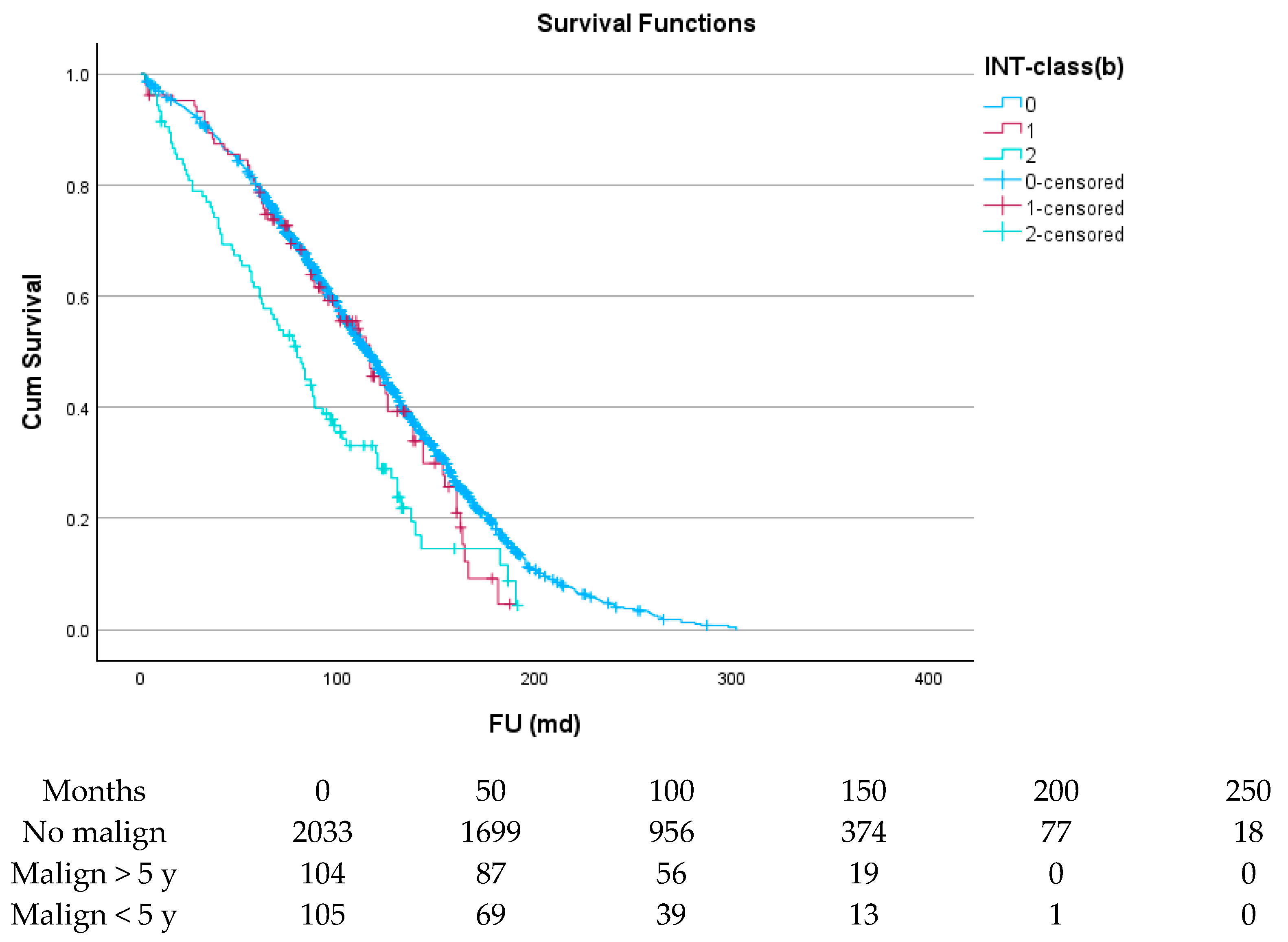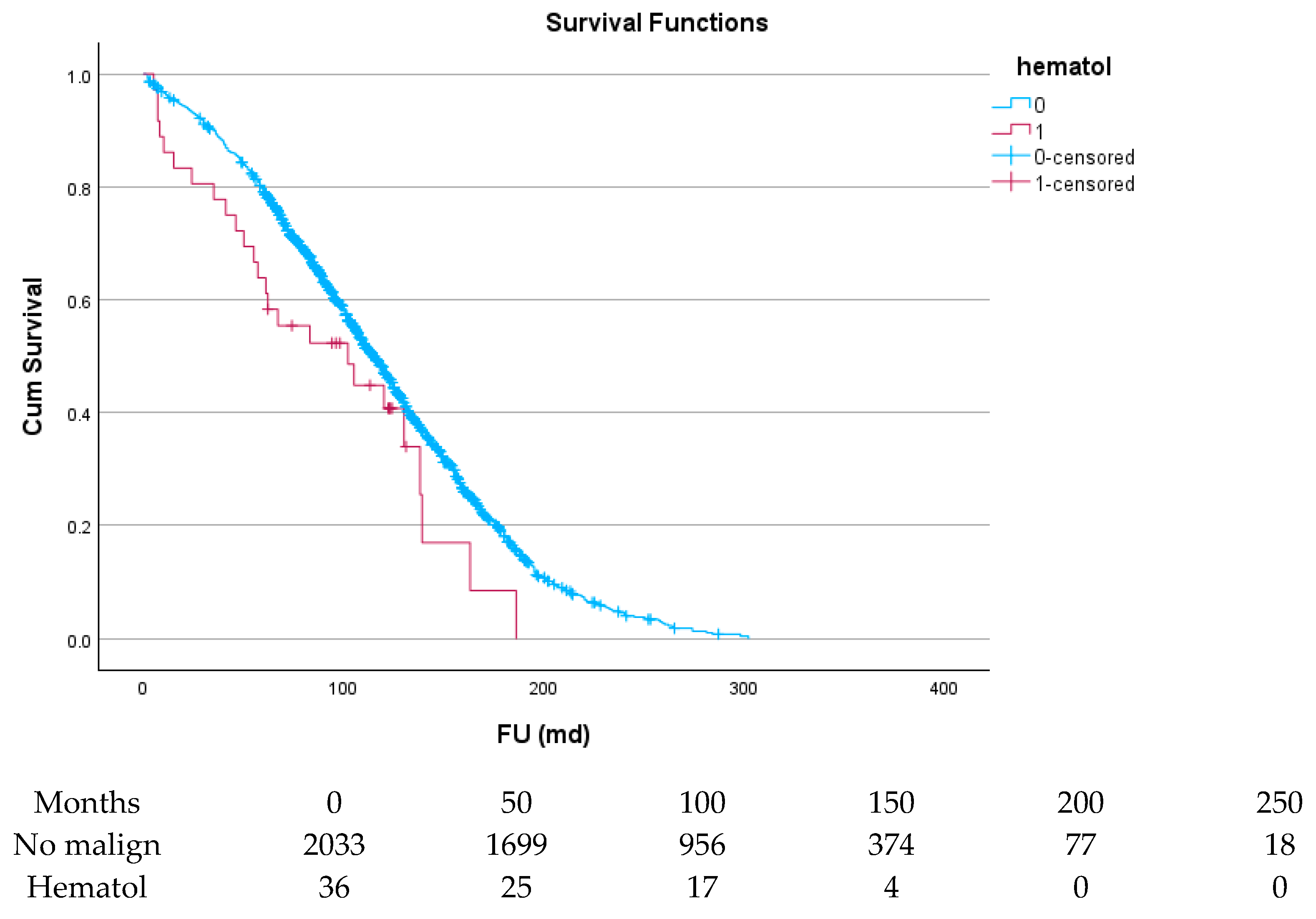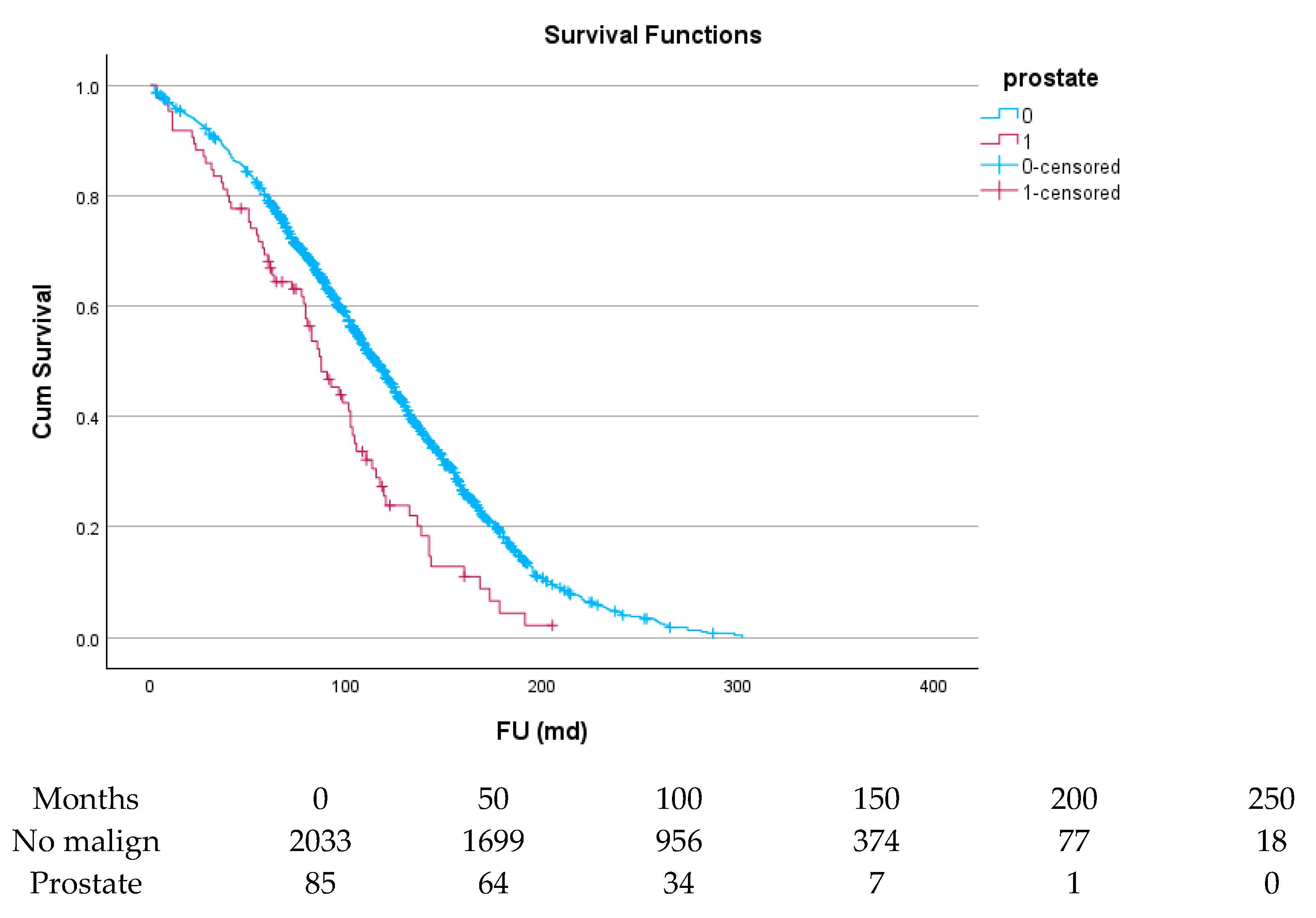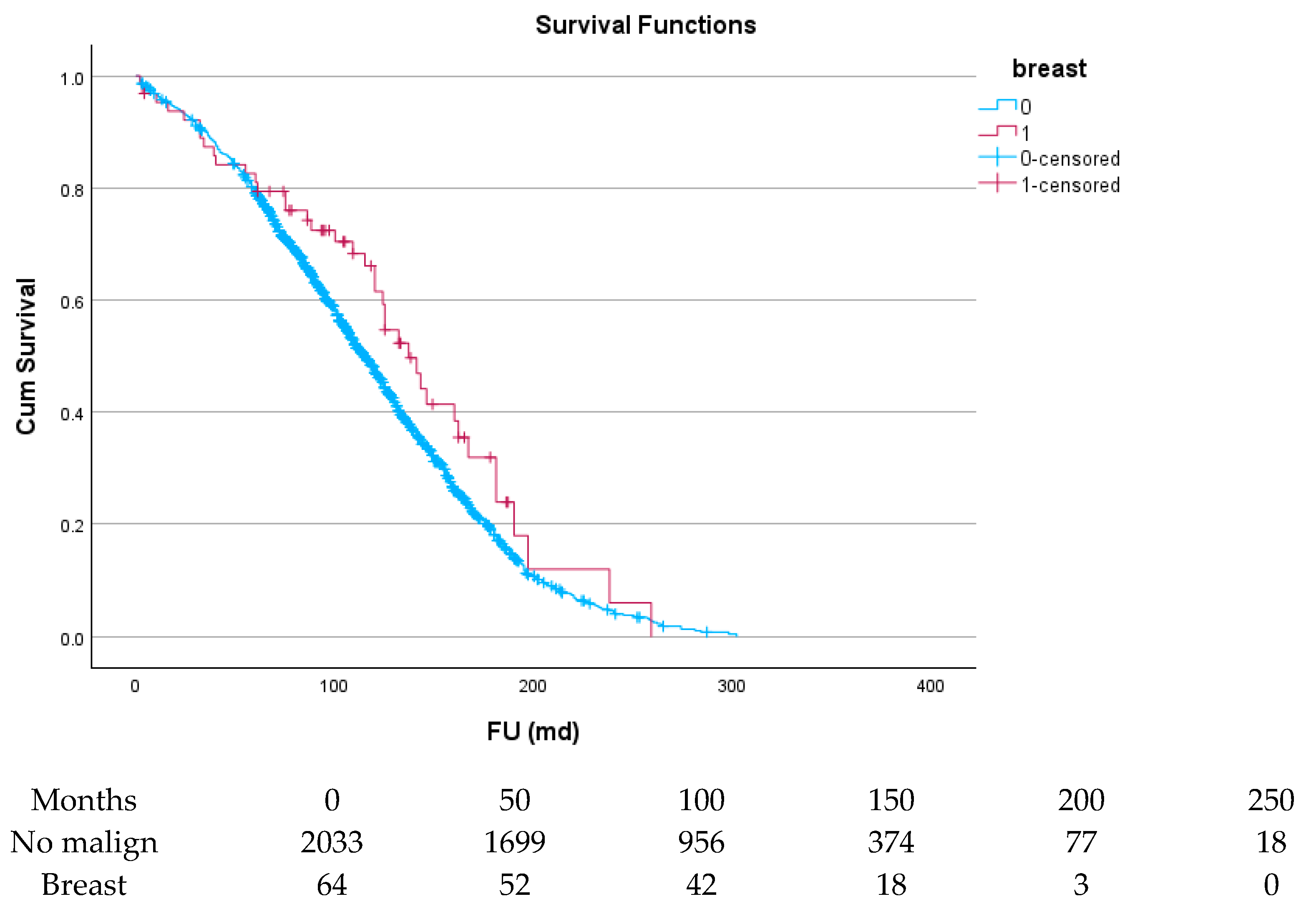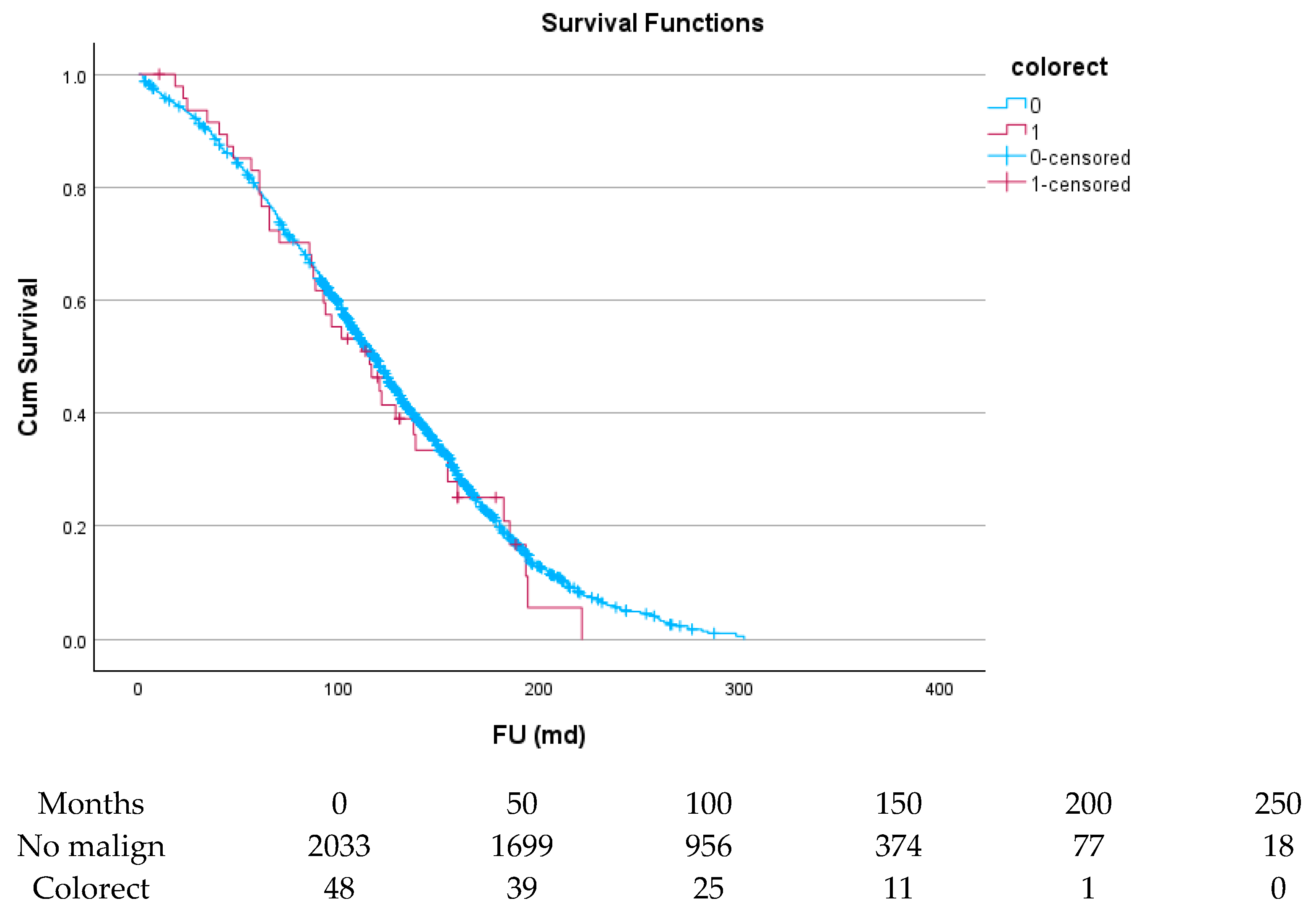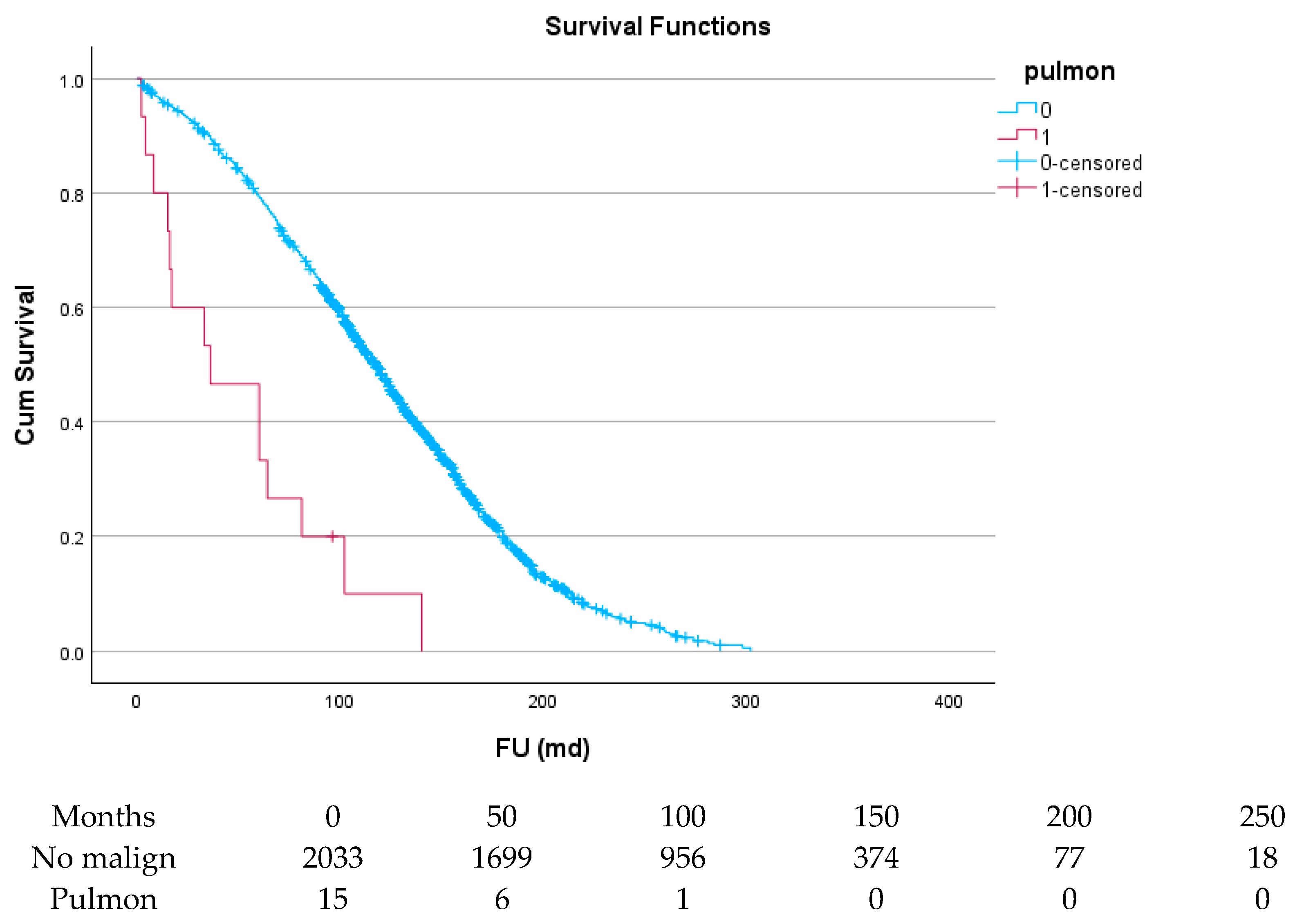1. Introduction
Malignancy and heart disease are the leading causes of death in Western societies [
1,
2,
3,
4]. There are several reasons why cancer survivors experience heart disease. These reasons include an increased life expectancy [
5], improvement in the management of cancer [
6], and common risk factors for both conditions. These include smoking, diabetes, obesity, and physical inactivity [
2,
7,
8]. These risk factors were significantly more present in cancer survivors compared to matched controls [
9]. Chronic inflammation and oxidative stress may have a considerable role in both cancer and cardiovascular disease [
10,
11]. Inflammation and oxidative stress are also involved in the development of calcific aortic valve stenosis [
12]. Cancer treatment could also have an impact on the progression of aortic valve sclerosis by major non-cardiac surgery, by autologous stem cell transplantation [
13,
14,
15], or by mediastinal radiotherapy [
16,
17,
18,
19,
20]. Irradiation of valvular tissues leads to fibrosis with thickening of the leaflets, calcification, loss of mobility with initial regurgitation with progression to stenosis, and involvement of the aortic root and the mitral valve apparatus [
21]. Despite the relationship between malignancy and heart disease, the incidence of prior cancer in cardiac patients varies. In our prior experience, this was 2.4% in a patient group referred mostly for coronary artery bypass graft (CABG) surgery [
22] and 9.5% in patients referred for surgical aortic valve replacement (SAVR) [
23]. The prevalence of prior malignancy in patients with severe aortic valve stenosis could be 20% or more in other series [
16,
19,
24,
25]. However, the incidental finding of an active malignancy in elderly patients referred for aortic valve replacement of any type was much lower, between 2.5 and 4.5% [
26,
27,
28,
29]. Both conditions limit life expectancy severely if left untreated. Congestive heart failure in aortic valve disease is a main driver for mortality in cancer patients [
2,
30]. Valve replacement resulted in improved survival compared to medical treatment [
31]. In the past, cardiac surgeons were reluctant to perform operations on cancer survivors because of an anticipated lower survival. Encouraging short- and mid-term results were observed after cardiac surgery in these patients [
32], and a prior malignancy was not identified as a predictor for 30-day mortality after SAVR [
23]. An interval between cancer treatment and cardiac surgery of 2 years or less was the main driver of reduced long-term survival [
22]. A survival benefit was observed in patients with severe aortic valve stenosis with simultaneous cancer if the latter was treated in an early stage [
2]. Transcatheter aortic valve implantation (TAVI) has been introduced as a less invasive treatment for high-risk patients and for patients with an otherwise short life expectancy. Patients with an acceptable prognosis after oncologic treatment could benefit from valve replacement [
16,
19]. There are, however, very few series studying the outcome of cancer survivors after SAVR in the long-term, with results after 10 years or more. This is, to our knowledge
, is the first large-scale monocentric series with respect to this complex problem. The research questions for patients referred for SAVR and prior malignancy are (1) What is the effect of the introduction of TAVI in 2008 on the referral of cancer survivors for SAVR? (2) Do patients with a prior malignancy have a higher degree of other comorbid conditions? (3) What is the early outcome (<30 days) after SAVR in these patients? (4) Do these patients need more postoperative resources? (5) What is the long-term outcome in these patients, especially after 10 years? (6) What is the long-term effect of the six most common malignancies? (7) What is the effect of the interval between the cancer treatment and SAVR on the outcome?
4. Discussion
This is one of the few large monocentric series dedicated to the difficult problem of cancer survivors needing SAVR. Its duration of follow-up is also exceptionally long. It also studies the effect of the six most common malignancies and the effect of the time-interval between malignancy and cardiac surgery. This interval serves as a chance for a cure. Our results show that patients with a prior or currently treatable malignancy have a comparable short-term outcome and need for postoperative resources. The long-term survival is reduced by 15 months. This reduction is mainly driven by a time interval between cancer treatment and cardiac surgery of less than 5 years. The presence of certain malignancies, such as lung cancer, and, to a lesser degree, prostate cancer and hematologic malignancies, also results in a more pronounced decreased survival rate. There is a reasonable expectation that the patient will experience long-term clinical improvement and increased life expectancy after SAVR. The prognosis of malignancy may limit the selection of patients for cardiac surgery, but this could also apply for other conditions such as severe chronic pulmonary or renal disease. Valve disease has been acknowledged as a serious side effect of cancer treatment such as radiotherapy of the chest. Because of radiation therapy, endothelial cells thicken and could become dysfunctional. The valve tissue starts to calcify [
19]. In prior series, patients with prior radiotherapy occurred in an important part of the patients referred to SAVR [
35]. Despite an increasing need for aortic valve replacement in cancer survivors, patients often were not considered for surgical treatment [
19]. The incidence of prior cancer in our series increased significantly over time, from 11.4% before the introduction of TAVI in 2008 to 17.7% thereafter. In a prior series, this cancer incidence increased with patient age and was comparable to current levels [
36] but lower than the observed 22.6% in those who underwent TAVI [
19]. This rate of cancer is higher compared to the series of cardiac surgery in general, which varies between 2% and 8% [
22,
35,
37,
38].
In the current series, patients with a prior malignancy were significantly older compared to those without cancer, but this difference was limited to one year. This difference was larger in a previously published nationwide series for patients undergoing SAVR: 69 versus 73 years. Patients referred to TAVI had a mean age of 81 years, irrespective of their cancer status [
19]. In another series, the mean age of cancer patients with aortic valve disease was 70 years for medical treatment, 72 years for TAVI, and 74 years for SAVR. This group was relatively small [
3]. In the current series, prior permanent pacemaker implant, chronic kidney disease, prior stroke, and male gender were more present in cancer survivors. These patients had less hyperlipidemia and chronic pulmonary disease. Other cardiovascular factors and operative data showed no significant difference. In previously published series, cancer survivors referred for SAVR had a considerably higher rate of coronary artery disease, prior percutaneous coronary interventions, atrial fibrillation, arterial hypertension, hyperlipemia, coagulation disorders, prior stroke, chronic kidney and pulmonary dysfunction, and smoking habits, but less obesity and cardiomyopathies. For diabetes, prior myocardial infarction, vascular disease, and neuropsychiatric disorders, there was no difference between cancer survivors and non-cancer patients [
19]. Patients who underwent prior radiotherapy of the chest had more LAD disease on top of aortic valve stenosis, but the aortic valve disease was less severe. More bypasses were needed after chest radiotherapy [
17]. Prior endocarditis was rare in the current series. The existence of a carcinoma can be associated with endocarditis through a port of entry such as colorectal neoplasias and immunosuppressive cancer treatments. If a cancer is treatable, valve surgery should not be withheld in these severely ill patients [
39,
40]. As in our series, prostate, breast, and colon cancers were most common in patients referred for aortic valve replacement [
19,
37,
38]. In another Japanese series, the most common tumors were prostate, lung, and gastric cancer [
41]. Hematologic malignancies were observed in 11% to 17% of the cancer survivors [
35,
38] and in 31% in another small series [
3].
In the current patient series, the mortality rate was 5% for patients without a malignancy and 7% for patients with a malignancy, which was close to the observed Euroscore of 6.70%. Except for atrial fibrillation, there were no more postoperative events in the current group of cancer survivors. The need for resources was also comparable. In prior series, a low hospital mortality after cardiac surgery was also observed in cancer survivors [
32,
37,
38]. One specific subgroup consisted of patients with prior chest radiotherapy. These patients suffered more from stroke, atrial fibrillation, and mortality after SAVR [
17]. About 10% of the current patients with a malignancy had a hematologic disease. These patients had a higher mortality rate of 10%, but this difference did not reach statistical significance because of the low numbers. The morbidity rate was significant, however. Bleeding and infections were most important [
42,
43,
44], but an increase in pulmonary and renal complications has also been observed [
45]. The increased need for resources was closely related to postoperative complications. The need for associated operative procedures and postoperative resources in patients with malignancy was not higher in the current series. This was reflected by a comparable cardiopulmonary bypass time and need for blood products, prolonged ventilation or renal replacement therapy, or pacemaker implant. The length of stay in the ICU or in the hospital ward was also comparable. A similar observation was made not only for patients with past but also with active malignancies [
37]. However, in several series, the need for intra- or postoperative transfusions was higher in patients with lymphoma or leukemia [
35,
43,
44,
45,
46]. Reoperation rate for various reasons was also high in patients with hematologic malignancies [
42]. The length of stay in the intensive care unit was prolonged to a limited degree [
45]. Patients with prior chest RT had increased surgical times, an increased need for blood products and permanent pacemaker implantation, as well as a prolonged length of stay in the intensive care unit. Readmission rate at three months postoperative was higher [
17].
Long-term survival in the current series was significantly lower for cancer survivors and was driven by a shorter interval between cancer treatment and SAVR and by the type of malignancy. Current results showed a divergence in survival curves after one year: the difference in 1-year survival was about 2%. After 5 and 10 years, this was almost 10%. Previously observed median survival time for patients with prior hematologic malignancy was approximately halved from 12 to about 6.5 years [
45]. Radiotherapy in patients with prior lymphomas can be associated with an increased rate of organ related complications, but the postoperative long-term results still were acceptable [
46]. Lower survival after SAVR, in general, was mainly attributed to cardiovascular events. This pointed to the need for earlier intervention but also to the need for a closer postoperative follow-up [
47]. Although prior malignancy was currently identified as an independent predictor for long-term survival, it ranked only 8th out of 10 parameters for its significance, while age, renal and pulmonary dysfunction, as well as peripheral artery disease, and diabetes were more important. In terms of clinical relevancy, expressed as an odds ratio, malignancy ranked as the last of ten predictors. A second malignancy did not occur more often with a first malignancy during long-term follow-up compared to a first malignancy in patients without such history. A lower survival rate because of metastasis could be expected if the interval between malignancy and cardiac surgery was less than 5 years. With a smaller interval, the chance of cure could be considered less likely [
22]. Readmission for malignancy and cancer mortality were higher in patients with active cancer, i.e., no interval [
37]. One-year survival after cardiac surgery (mostly CABG) is not affected by the interval of 5 years [
35]. The stage of cancer also showed an effect on survival in prior series, with a higher survival in early stages, but even in patients with active cancer and severe aortic valve stenosis, a survival benefit of SAVR could be documented [
48].
The current results show that the introduction of TAVI as a less invasive treatment for aortic valve stenosis did not result in a diminished referral of patients for SAVR. Earlier series indicated that reasons to replace the valve in cancer survivors were the severity of valve symptoms, a requirement to replace the valve in anticipation of cancer surgery, and the severity of aortic valve stenosis, while absence of symptoms and a limited life expectancy not related to the valve condition were reasons not to replace the valve by either method [
41]. TAVI has the advantage of being less invasive and allows earlier resumption of anti-cancer treatments, without having a difference in overall survival between SAVR and TAVI. Moreover, the introduction of TAVI could reduce the number of patients who would otherwise not be considered for treatment of valve disease [
1,
49,
50]. Despite the introduction of TAVI in 2008, we documented an increase in referrals for SAVR. The ratio of patients with cancer also increased over time. We observed a difference in postoperative 5-year survival before 2008 of about 13%, while after 2008, this was about 6%. The difference in survival between cancer and no-cancer patients clearly narrowed due to improvement in care.
This study has clear limitations. TAVI, as a recognized treatment of aortic valve disease, was not a part of the study design. There is a long inclusion time with changing operative and perioperative care and oncologic treatment modalities. Current data, however, do not allow us to make a distinction between the improvements in cancer treatment and in cardiosurgical techniques over time. Other limitations are the lack of information about the stage of cancer and the treatment modalities, but treatment with curative intent or a potential cure of concurrent malignancy can be assumed. The interval between cancer treatment and SAVR can be considered as a measure for the likelihood of cure. This parameter is known in most patients. The current follow-up with respect to mortality is complete, but the cause of death is not always known. The reason is the admittance in skilled nursing facilities of many patients because of high age and other, unrelated disabilities such as dementia and poor mobility. An analysis for competing causes of death is therefore unreliable. The low survival in patients with a postoperative progression of a prior malignancy is an indication of the importance of the interval between the malignancy and cardiac surgery. The follow-up is through exploration of the digital files and depends on the completeness of the information. There is limited availability about past or current smoking and other relevant habits concerning cancer. Both patient groups had some differences in preoperative comorbid conditions. A Cox’ proportional hazard analysis was used as a valid alternative for a propensity score match analysis.
